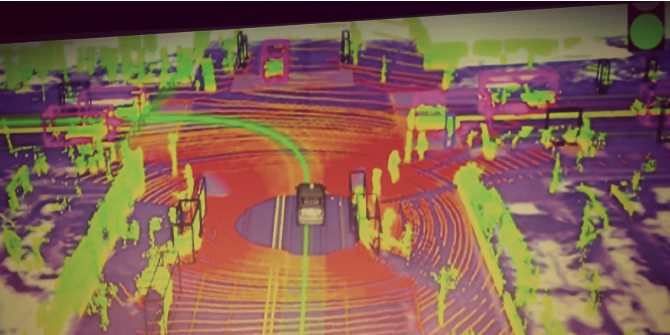 In legal studies, discussion of new technologies has often focused on the risks to privacy and data protection. Mariana Gkliati outlines how such technologies may be seen not only as Orwellian threats but also as opportunities for human rights research. Some advances have already been made and there remains much to learn from other fields. However, to build on such progress institutions must be prepared to invest in developing technologies, encourage interdisciplinary work and establish a robust ethical research framework.
In legal studies, discussion of new technologies has often focused on the risks to privacy and data protection. Mariana Gkliati outlines how such technologies may be seen not only as Orwellian threats but also as opportunities for human rights research. Some advances have already been made and there remains much to learn from other fields. However, to build on such progress institutions must be prepared to invest in developing technologies, encourage interdisciplinary work and establish a robust ethical research framework.
In a field like legal studies, where so little attention is paid to methodology, or at least to making it explicit, the choice of the International Research Conference of the Association of Human Rights Institutes, hosted in early September by the Netherlands Institute of Human Rights, to dedicate its plenary session to ‘Re-inventing Human Rights Research’ is commendable.
There, in an exciting talk, Professor Lorna McGregor, Director of the Human Rights Centre of the University of Essex, introduced the use of new technologies and big data in legal research on human rights.
In the context of human rights, new technologies are most commonly discussed with respect to their risks to privacy and data protection. In the field of migration, European databases such as the Schengen Information System and the Visa Information System hold tens of millions of pieces of data on migrants; putting their privacy at risk and casting a shadow of criminal suspicion over border crossers. The revelations of Edward Snowden, disclosing details of global surveillance programmes, and the work of organisations such as WikiLeaks and Statewatch leave no doubt as to the risks of new technologies and big data sets and the need for adequate safeguards for the protection of basic rights.
 Image credit: geralt (public domain)
Image credit: geralt (public domain)
Insights from Lorna McGregor’s talk
Keeping in mind these risks, Prof McGregor pointed out that they can also be a valuable tool for human rights research and advocacy. Technology has proven vital in documenting, reporting, and monitoring human rights violations and large-scale atrocities, while the processing of big data allows for mapping trends and patterns. Mining several data sets can be used to look at the effects of policies and hold actors accountable, as has been shown in the field of healthcare. Finally, human rights research can capture the full potential of new technologies, following the example of employment and debt-related research that make use of data-based algorithm decision making.
However, if legal research is to be part of the big data revolution and not be swept away by it, it needs to meet the challenges the latter presents. Such research requires considerable resources with respect to time, financial investment, and expertise. Most importantly, ethical and security concerns (storing, using, and sharing big data; hacking; anonymity; etc.) need to be taken into account. Furthermore, Prof McGregor highlighted the need to be critical of biased data representations, as well as of the accuracy and possible tactical manipulation of data sets. She also emphasized the need to strengthen the existing regulatory frameworks and have a human rights approach to the risks and limitations of using big data.
What has been done and what more can be done?
Indeed, numerous examples have already appeared in human rights research and advocacy. Amnesty International is using geospatial technologies like satellite imagery for human rights monitoring and prevention. The Witness Program trains and supports activists and citizens around the world to use video safely, ethically, and effectively to expose human rights abuses and fight for human rights change. Freely accessible, interactive maps present the latest information on the Syrian civil war and the war against ISIS. At the academic level, initiatives such as ‘Human Rights Texts: Converting Human Rights Primary Source Documents into Data’ promise new threads of knowledge. Berkeley Law Faculty of the University of California runs the Human Rights and Technology Program dealing with data accountability issues, forensic methodologies, and new investigative techniques for violations of international humanitarian and human rights law.
Furthermore, new tools that can encourage such research have become freely and easily available. For instance, Kumu helps to handle and visualize data, while YouTube’s face blurring tool provides visual anonymity allowing the use of evidence of human rights abuses in public presentations and research work.
Nevertheless, young human rights researchers need to be encouraged to become part of this new environment, become more explicit in their methodology and experiment with new technologies and methods already proven in different fields.
For this to happen, law schools and research institutions need to cultivate breakthrough leadership in supporting interdisciplinary research; not for the sake of interdisciplinary research, but proactively bringing useful disciplines together. The introduction of social, health, and natural science methodologies and the use of new technologies in undergraduate and postgraduate programmes can be a first step in this direction. Furthermore, more conferences and seminars can follow the example of the AHRI and discuss big data initiatives and technology-inspired research.
Delving into such research also requires new allocation of resources from the institutions, including technological capacity and direct technical support. The employment of statisticians and computer scientists to support research at law schools is fundamental if a serious effort is to be made. Due care and attention is also required with respect to the scientific literacy of the researchers themselves, for instance with respect to data mining or predictive modeling and simulation techniques.
Finally, such efforts should be complemented with a parallel investigation into the impact of digital technologies on human rights and the rule of law, including privacy, data protection, and cyber security. The complexities, limitations, and risks of such research need to be addressed through binding and enforceable ethical research principles and practices.
This new approach seems foreign to the seemingly detached and alienated world of traditional black-letter legal research, but the first encouraging steps have already been made. The rest will follow.
This piece originally appeared on the Leiden Law Blog and is reposted with the author’s permission.
Note: This article gives the views of the author, and not the position of the Impact of Social Science blog, nor of the London School of Economics. Please review our comments policy if you have any concerns on posting a comment below.
About the author
Mariana Gkliati is a PhD candidate at the Institute of Immigration Law of Leiden University. She specializes in human rights protection in Europe and European Migration Law. Her doctoral research focuses on the legal protection of individuals against human rights violations in the area of asylum and immigration attributed to EU agencies, in particular Frontex. Her work experience is shared among Vienna, Athens, and Leiden. She has previously worked at the EU Fundamental Rights Agency in the area of asylum, migration, and borders and as a legal case reporter and commentator for Oxford Reports on International Law database. In her early career she has worked as a journalist and voluntarily assisted the NGO, AITIMA, which provides legal and social aid to asylum seekers and refugees.







